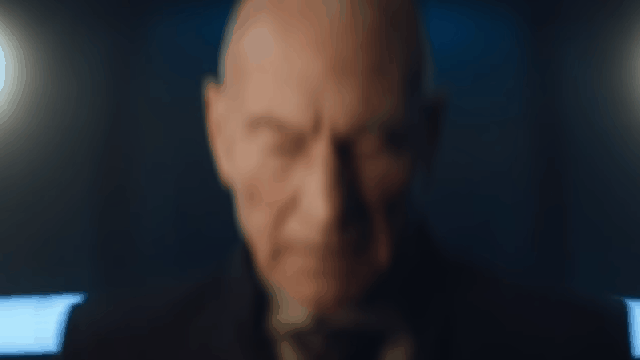Star Trek: Picard is set decades after the unthinkable: a disillusioned Jean-Luc Picard, former captain of the Enterprise, has left Starfleet, the fabled organisation that represents his highest ideals. But in order to figure out why, we need to turn to what might be a surprising source for some Star Trek diehards.
The first trailer for Picard only offers the barest of hints as to just why Picard—now an Admiral by the time of his exit—left Starfleet. We hear a brief, vague summation of Jean-Luc’s exit from an unnamed Starfleet officer (voiced by Merrin Dungey):
Fifteen years ago, today, you lead us out of the darkness. You commanded the greatest rescue armada in history. Then? The unimaginable.
But while the trailer keeps that “unimaginable” event hidden, we actually know what it is already—because Alex Kurtzman revealed in an interview with the Hollywood Reporter months ago that the CBS All Access show is actually set after an important series of events that inform the set up for the 2009 Star Trek movie reboot.
The vast majority of Star Trek 2009 is set in an alternate 23rd century, retelling the early years of James Kirk and his familiar iconic crewmembers aboard the Enterprise. But that alternate timeline exists thanks to some 24th-century shenanigans that Picard is set after: the destruction of the Romulan Star Empire’s homeworld Romulus in 2387, over a decade after the conclusions of Deep Space Nine, Voyager, and the final The Next Generation movie, Star Trek: Nemesis.
As told in flashbacks forming the prime timeline Spock’s story in the movie, Romulus’ destruction is caused by a nearby star going supernova. The Romulan Senate had tasked Spock (at the time an ambassador to the world for the Romulans’ distant cousins, the Vulcans) with using an experimental ship called the Jellyfish, which housed a drive containing red matter, to contain the dying star in a black hole before its explosive potential consumed Romulus.
Unfortunately, Spock’s attempt came too late: the supernova expanded far more rapidly than previously anticipated, destroying Romulus entirely. The red matter black hole the Jellyfish created to contain the supernova before any more damage could be done only served to pull both the ship and the nearby Romulan mining vessel Nerada into a rift in space and time—catapulting them back to 2258 and establishing an alternate timeline we now know as the Kelvin Timeline (named for the divergence caused with the destruction of the U.S.S. Kelvin by the Nerada in Star Trek 2009’s opening). Back in the 24th century, Romulus and billions of Romulans are gone, the supernova is dealt with, and Spock is mourned after being presumed among the dead.
With that, what we officially know of the main Star Trek timeline in the 24th century comes to an end. Picard will be the first officially canonical Star Trek material to be set after the events that opened Star Trek 2009—in around 2402, judging by the “fifteen years” comment Dungey’s character makes in the trailer.
We’ll have to wait and see the show itself (“coming soon”) to get the full picture of the events around Romulus’ destruction. The only thing we know for sure is the fact that Picard seemingly lead a rescue flotilla that attempted to save survivors fleeing Romulus which…presumably failed, given he promptly quit Starfleet and went off to Burgundy to go make wine.
What remains to be seen beyond that is what will officially become the story before and immediately after those moments from Star Trek 2009. Currently, two non-canonical Star Trek products have given us potential glimpses. In the run-up to the movie’s release in 2009, IDW published Star Trek: Countdown, a four-part miniseries by Mike Johnson, Tim Jones, and David Messina that set up the lead up to Romulus’ destruction. It not only gave the star a name—Hobus—but established a post-Nemesis future where Picard was not an Admiral, but the Federation Ambassador to Vulcan (Data had become his replacement aboard the Enterprise-E, having planted his memories and personality into the android B-4) and personally involved with Spock’s mission to save the world.
Meanwhile, the ongoing MMORPG Star Trek Online, initially set in 2409, is based entirely around a premise where the destruction of Romulus—and its sister world Remus, home to the Remans—by the Hobus star has vast-reaching consequences for Star Trek’s wider galaxy.
Just as it seemingly has in Star Trek: Picard, in Online’s future the destruction of Romulus has lead to the total dissolution of the Romulan Star Empire, and with its absence, a power vacuum that briefly sees the Federation and Klingon Empire break its years of truce and re-enter a period of war. The fascistic Romulan secret police, the Tal Shiar—lead by Denise Crosby’s TNG character Sela, the half-Romulan daughter of Tasha Yar—attempts to control what’s left of the surviving Romulans, while a breakaway group calling itself the Romulan Republic established a new homeworld called New Romulus, reaching out to both the Federation and the Klingon Empire in an attempt to bring the two factions together to support the fledgling group’s re-integration into galactic society.
Those are just two possibilities rather than actual moments in Star Trek’s television timeline, however. Whatever version Picard tells will override both as apocryphal might-have-beens, establishing new canonical events for Star Trek’s future for the first time since Star Trek 2009 briefly glimpsed a post-Nemesis timeline. But beyond pondering what could become, it’s still interesting to see that a reboot looked down upon by some Star Trek diehards will directly inform the return of one of the franchise’s most beloved icons.
